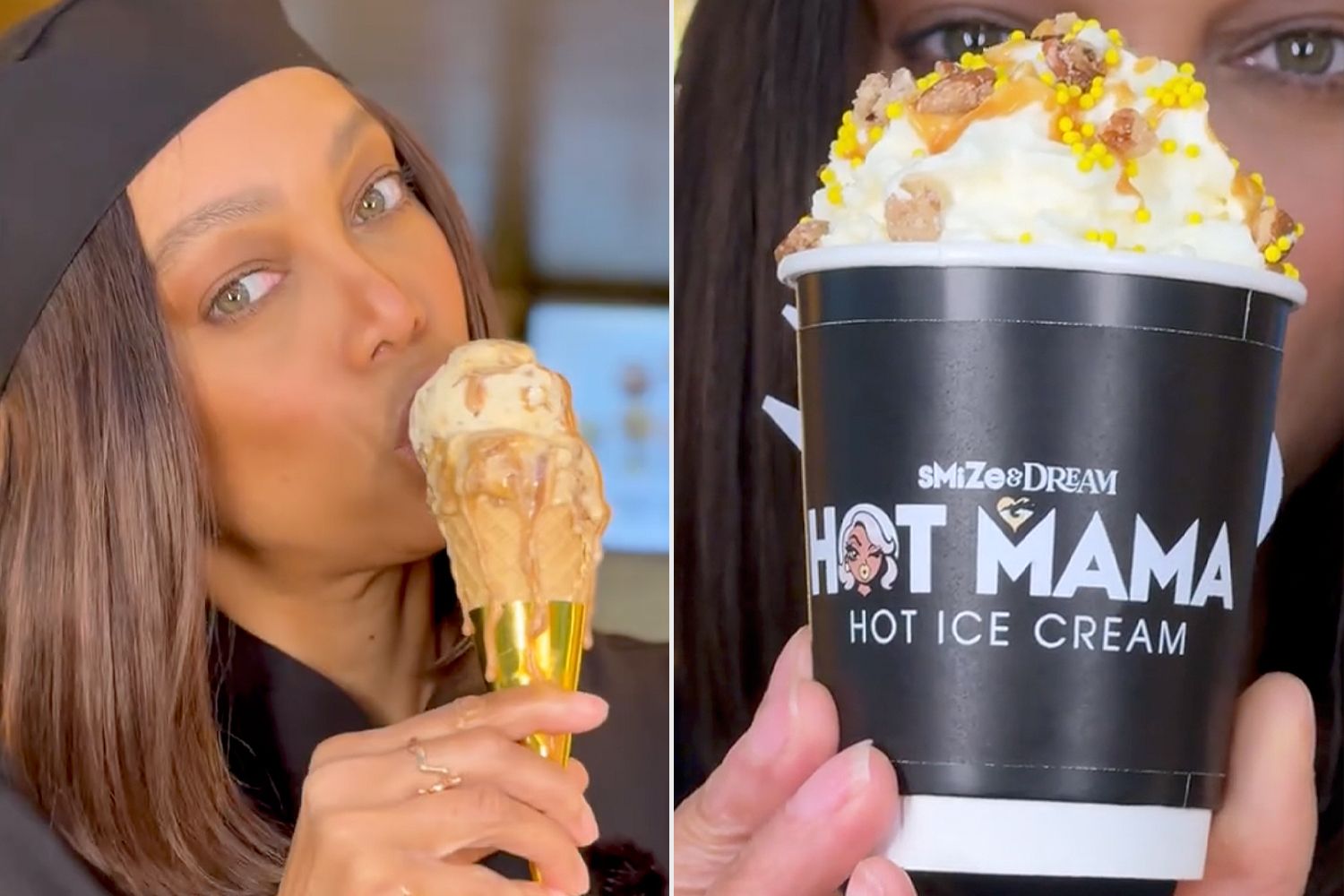Tyra Banks has always been a force of reinvention, whether on the runway, behind the camera, or in front of it. So it should come as no surprise that her newest venture is proving, in its own wild way, to be perhaps her boldest twist yet. Back in 2024 and early 2025, fans watched as she quietly prepared for something unexpected — a dessert concept that would challenge conventional expectations of what “ice cream” means. In September, she announced HOT MAMA, a dessert she calls “the world’s first HOT ice cream experience.” It’s not a latte, not hot chocolate, and — she insists — not just melted ice cream. And when she opened the flagship Smize & Dream store in Sydney, Australia, earlier this year, she committed fully to unveiling that concept to the public.
Already, social media has erupted. Some people are intrigued, others baffled, and plenty skeptical. The reaction has been loud. But Tyra, ever the showwoman and innovator, is leaning into it. She’s always been someone to court conversation. This time, though, the conversation isn’t about modeling or beauty; it’s about dessert — and whether someone would pay for a scoop that’s been warmed up.
To understand how daring this is, you have to picture what’s usual for ice cream: cold, creamy, refreshing, indulgent. It’s a treat you often eat on a hot day precisely because it cools you down. Tyra’s HOT MAMA defies that script. She says the product has been in development for a year, and when she describes it, she does so provocatively: “And no, I’m not talking about me in a swimsuit in the 90s, although damn I was hot.” That kind of tongue‑in‑cheek tone is par for her brand. What’s more interesting is how she draws a line: she’s “not talking about a latte,” she’s “not talking about a flavored hot chocolate.” The product is something else — a heated dessert that anchors itself somewhere in the world of ice cream but with a twist.
That ambiguity has fueled much of the public’s reaction. On social media, people have asked, “Sooooo… a warm milkshake?” Others have said things like “melted ice cream in a cup?” or even “hot milk.” At face value, one can see why people would jump there — maybe it’s just an ice cream that’s been heated, or something more like a flavored custard. But Tyra clearly wants the challenge of reframing expectations. She wants people to taste her vision and decide.
Her debut flavor, Tyra’s Favorite, was released at the Sydney store for just seven days. It featured toasted pecans, salted cream, and caramel butter — flavors deeply rooted in classic dessert territory, but reimagined in her hot-ice-cream framework. The limited window only added to the mystique: seven days, and then it’s gone. In late September, Tyra’s team posted about it with fanfare. The push was to create a moment — something fleeting, talked about, perhaps even controversial.
Shortly after, she announced a second flavor, Fairy Dough Diva. This one felt more playful, more theatrical — buttery vanilla biscuit–infused hot cream, topped with Chantilly (whipped cream), rainbow “hundreds & thousands,” and crowned with a slice of house-made fairy dough crunch biscuit. Again, this would only be available for a week. The phrasing in her announcement — calling it a “couture SMiZE cup,” and saying “after that? Poof. Her curtain will close.” — further shows she views this not just as food, but performance. Every flavor is an event, every release short and dramatic.
When she first popped this concept publicly, there were some experiments: a pop-up shop in Washington, D.C. in 2024. That gave her a little test bed outside Australia. It allowed her to feel the reaction, to refine details, to test logistics. Now, the flagship in her new base of Sydney is both a statement and a laboratory. From there, her ambitions are global. She’s spoken about bringing Smize & Dream to the U.S. in 2026. Some of her advisors caution to wait until 2027, but true to form, Tyra is pushing against conservative timetables. She’d rather shock, launch, and adapt than wait for what she sees as slow-moving consensus.
But all of this begs a question: will it work?
A dessert concept, even a new brand or flavor, is one thing. But hot ice cream challenges the very definition of a category. Will people pay for it? Will it feel satisfying? Will it taste right? And more fundamentally, will it displace or sit beside cold ice cream?
Some of the reactions are simply playfully critical: “warm milkshake,” “hot milk,” “melted ice cream.” Others are more cautious: “Isn’t this just a gimmick?” But gimmicks, especially in food, sometimes stick — provided they have substance under the veneer of spectacle. Think of cronuts, bubble tea, black‑colored burgers, or neon doughnuts: weirdness has often been the catalyst for curiosity. But sustaining it means quality, consistency, scalability, and convincing indifferent people to convert to believing in your twist.
If Tyra can get balance in texture, temperature, and flavor, she might hit something novel enough to withstand scrutiny. Imagine a dessert that’s rich and creamy, thick and luscious, served warm but not to the point of collapse or soupy fluidity. Something that holds its shape, delivers sweetness, nutty or buttery or biscuit-like notes, and surprises your palate. If she overcooks it, or doesn’t calibrate the sweet, or loses that ice-cream mouthfeel, it could devolve into “just hot custard” — or worse, “hot milk” in people’s minds.
Part of the challenge is what people expect. When someone hears “ice cream,” they anticipate cold comfort — a chilly treat. When that expectation is negated, some will feel cheated or disoriented. Even if the hot version is delicious, the mental barrier is real: “ice cream must be cold.” Working against established mental models is harder than creating a new flavor.
Then there’s the freak factor: people will be curious — some will walk in just to try the novelty, some will order a second time if they’re converted, and some will quietly walk away muttering about Tyra’s latest whim. The limited‑time, drop‑style flavor releases help amplify hype and scarcity. It’s a smart move: people like urgency. The short windows push “be there or miss it” energy.
Also, by positioning it as a couture experience — “Smize cup,” theatrical names, timed releases — she’s leaning into her brand persona. She’s not just selling food; she’s selling spectacle and identity. This was always her turf: aesthetics, performance, glamour. Making dessert part of that realm is a natural evolution for someone whose career has always been about style, image, and reinvention.

For Sydney, it’s a statement: she lives there now, she’s investing locally, and she wants the store to be a flagship that proves the concept. If she can make the logistics smooth, get the kitchens right, ensure consistent temperature control and quality, hire staff who can handle the theatrics, and maintain supply chains for specialty ingredients, then scaling further becomes possible. The D.C. pop-up was likely a test — find what breaks, find how people react, refine recipes. Now she’s doing it full blast in her home base before pushing outward.
Looking ahead to her U.S. plans, 2026 is ambitious. There are more variables: different consumer expectations, colder climates, more competition, more scrutiny. A concept that feels daring in Sydney might feel gimmicky or overengineered in New York or Los Angeles. There’s also regulatory and operational challenges: food safety around heating and holding dairy at certain temperatures, consistency across locations, shipping, staffing, branding coherence.
Then there’s marketing. To make “hot ice cream” something consumers want beyond “let me try it once,” she needs narrative, storytelling, media, influencers, experiential campaigns. Tyra knows media, and she knows how to create a persona-laden brand. She’ll likely use her platform, her networks, celebrity friends, launches, events, social media stunts. She might invite food critics, influencers, press, and let them try to decode it. Some will love, some will ridicule — but in that friction lies attention.
Of course, she has ammunition: she is Tyra Banks. She has name, brand, audience. She can call attention to this in a way many food startups cannot. She has the cultural legacy, money, access, and media savvy. That gives her room to experiment and absorb failures that a lesser-known entrepreneur might not survive. Because if one flavor flops or a local store struggles, she has the brand buffer to say “next drop, next version.”
But there’s still the risk of being seen as a stunt, only marginally more than transient curiosity. If she can’t turn first-time tasters into returning customers, she may find her product is a novelty, not a sustainable dessert competitor. And in food, novelty without repeatability — without people loving it enough to crave it, buy it again — can fade quickly.
Still, I see something compelling in the audacity of the idea. In a consumer world saturated with incremental new flavors — mint chocolate chip with a twist, salted caramel swirl, exotic fruits — Tyra is attempting a structural shift: temperature. That’s different. It’s bold. If it works, she’s not just offering one more flavor; she’s offering a new category. And if she nails the texture and the flavor, the novelty becomes the gateway.
If you imagine sitting in her Sydney store, on a cool evening, being handed a small couture cup with a warm, silky, sweet creation — somewhere between cream, custard, and ice cream — you taste toasted pecan, salted cream, buttered caramel. You swirl it, take a spoonful. There’s heat, but not scalding; richness, but not weight; creaminess, but not icy cold shock. That tension could be magical. Or, if the calibration is off, it could fall flat: lukewarm milk, too hot, too thin, or too sweet without depth. The risk is high, but the reward is intriguing.
What will matter is iteration, feedback, transparency, adaptation. Tyra needs to listen to customers: what feels off, what texture feels too “custardy,” what sweetness might be excessive, what mouthfeel is missing. She’ll need to refine. Each flavor drop is not just a spectacle; it should also be a learning opportunity. If the second flavor has stronger execution, she can build momentum. If it stumbles, she can reverse, learn, tweak.
In the court of public opinion, she’s already scored a win: people are talking. That’s step one. The next is getting people to convert: from curious to believer to repeat buyer. If she can win a few devoted fans in Sydney, they become ambassadors, generate word of mouth, bring others in, and the hype can compound.
Also, the limited drops may help reduce waste and risk. She isn’t committing to a full menu of a dozen hot-ice flavors at once; she’s launching one or two, short runs, see what sells, see what people love, then expand outward. That mitigates the downside of full-scale failure.
One question is whether she will also offer a “cold version” for those who balk at warmth, or some hybrid. People might yearn for contrast — a scoop of cold alongside warm, or a swirl of both, or a “transition” plate. But Tyra seems determined to differentiate: she’s not doing “ice cream warmed up”; she’s doing hot ice cream. If she dilutes that, she risks losing the brand edge.
Another question: would this concept work everywhere? In Sydney (which can be temperate or warm), a warm dessert might feel luxurious or comforting. In hot climates, people might not want more warmth. In cold climates, the novelty could seem less appealing. She’ll have to tailor marketing and perhaps even tweaks in texture or portion size regionally.
Yet food trends thrive when they come with stories. People love to be part of something new, to taste the talked‑about item, to share on social media, to be “in the know.” Tyra’s brand is well suited to that. Someone ordering Fairy Dough Diva in a couture cup, snapping a photo, tagging it — that’s social content. Each drop is content. The scarcity pushes shares. So even if the majority remain skeptical, a passionate core could make it viable.
In the end, I think Tyra’s concept will survive or fail based on execution more than idea. The idea is audacious, conversation‑starter, brand‑amplifying. But lots of audacious ideas die because they don’t deliver the sensory promise. If she leans too heavily on spectacle and too lightly on flavor and texture, people will abandon it. But if she balances both — the taste, the feel, the warmth, the creaminess — she might pull off something memorable.
This is, in many ways, peak Tyra: confident, provocative, pushing a category boundary. The critics are welcome; she thrives in visibility. But the customers are the ultimate arbiters. If one day people in Sydney begin to ask “Hey — hot ice cream tonight?” and people respond, “Yeah, I’ll go with you,” then we’ll know she’s created something real, not just a stunt.

So would I try it? Absolutely. I’d want to taste what happens when she dares to invert the cold dessert trope. Is it cozy? Is it comforting? Is it strange in a good way? I’d want to see whether that tension — hot, creamy, sweet, structured — is more than novelty. If she nails it, Hot Mama could become a niche dessert category people ask for. If not, it will be one of those celebrity food ventures that people remember for the audacity, rather than as a lasting success.
But whatever happens, Tyra’s latest move is worth watching. In a world where new flavors and hybrid desserts are common, she’s not just asking what tastes good — she’s asking how we want our desserts to feel. And that’s a question that makes you lean in.










